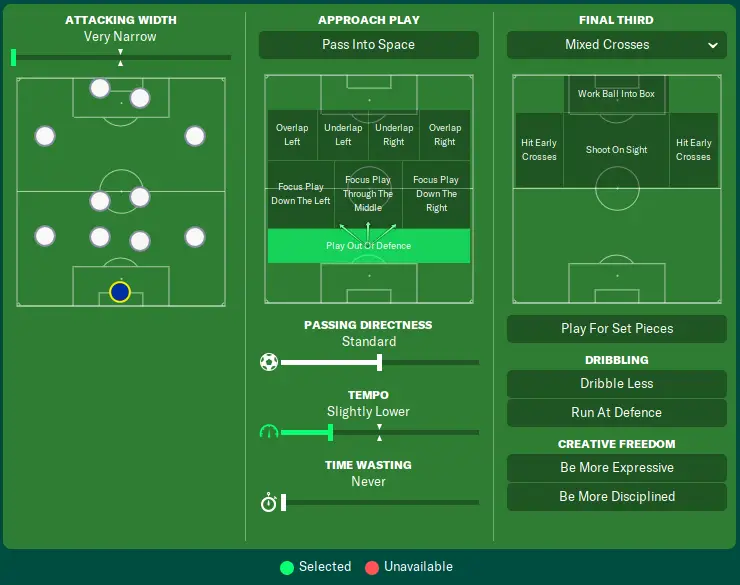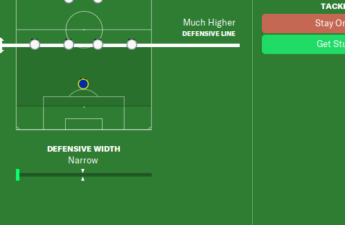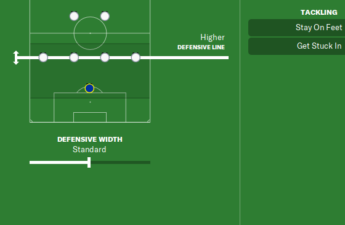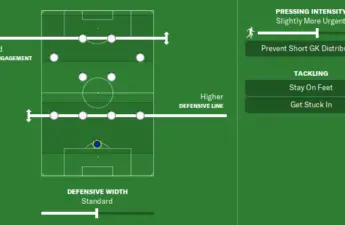Whether you want to play peak Pulisball that will have the ball cover the entire pitch in three or fewer touches, an intricate short passing style mirroring Pep’s Barcelona or a style in between the two that balances keeping possession and creating chances, all viable play styles in football manager, you first have to start with settling on your team’s passing directness.
Football manager has five levels of passing directness, with much shorter passing at the low end and extremely direct passing at the other extreme.
In this article, I will highlight all these levels of passing directness in FM, discussing where it is best to use them depending on the strength of your team, the opposition you are facing and the kind of football you want your team to play.
Much Shorter Passing in FM
Football manager describes much shorter passing as a team instruction that places an increased emphasis on instructing players to prioritize keeping hold of the ball.
With this instruction toggled on, your team will prefer making short passes to the nearest teammate, shying away from trying passes that cover a large distance in case it is intercepted by the opposition.

The team will always choose the safest passing option, even when an opportunity arises that would see your striker played in by one of your playmakers. The priority is keeping the ball.
You might want to employ a much shorter passing style for various reasons.
Much shorter passing is effective when seeing out a tight game that you want to keep the scoreline as it is, without being caught on the counterattack trying to add to your tally.
Say you are managing a big team that has a one goal lead in the last 15 minutes of the game.
Rather than packing the bus, as a small team would, you can instead ask your players to take a risk-free approach in their passing, retaining the ball and seeing the time tick to the full 90 minutes.
The second scenario could be that your defence is not particularly strong, but you have a midfield that is capable of keeping hold of the ball for long stretches of time, essentially starving the opposition of the ball and reducing the number of times that your poor defence has to face the opposition’s strikers.
Shorter Passing in FM
Shorter passing is described by football manager as an instruction that instructs players to adopt a style of play based around shorter passes and greater ball retention compared to the style generally adopted by the team’s current mentality
While much shorter passing and shorter passing focus on greater ball retention, shorter passing gives the team some freedom when it comes to locating players who are slightly farther away, making it possible to use the instruction as the basis for a tiki-taka style of play that still carries a threat in attack rather than having the ball for the sake of it.
Shorter passing reduces the distance and risk of the passes the team would normally employ when on a certain mentality.
Say you are on the attacking mentality, shorter passing here would have the team refrain from making certain risky passes that they normally would employ if they were using the default (Standard) passing directness of attacking mentality.
If you have the players for it, shorter passing can give you the high possession stats that you want, while still being effective in racking up the chances for your complete forward or deep lying forward to feast on.
It is advisable to have a playmaker in this kind of system can be a deep lying playmaker, regista or advanced playmaker, who will ideally have the vision and passing range to find your forward players when you face defences that sit back and hand over the initiative to your team to find the way through.
Standard Passing In FM
Standard passing is more straightforward in football manager with the kind of passing at this level determined by your team’s mentality.
The very attacking mentality will see the team make extremely direct and risky passes, while the very defensive mentality on the other end will see the team keep the ball with no aim of creating chances and then hoofing it clear when they are out of safe passing options.
More Direct Passing in FM
More direct passing in football manager asks players to adopt a style of play based around quicker transition from back to front than would be standard under their team mentality with the ball covering long distances in a quicker amount of time.
You would ideally use this instruction if, for instance, you want your team to be more cautious out of possession in their defensive shape, but still retain the freedom to make risky passes that cover longer distances when they get on the ball.
A great opportunity to use this would be when facing a stronger opponent in their home ground, but you still have the players with the technical ability to quickly transition on the counter-attack to inflict some damage.
To neutralize the opposition’s attack, you might start on a lower mentality like defensive or cautious, however, the more direct passing team instruction would make it easier to get the ball to your forward players once you win the ball back deep in your half.
The threat that your attackers pose on the counter-attack will make it difficult for the opposition to pin your team in your own half under waves of unrelenting attacks.
The more direct passing suits teams that play with a narrow attacking width, since you do not need the entire pitch’s width to stretch the opposition and find gaps in their defence.
This is not to say you can not find success with a wide attacking width, as wingers and other roles in the wide positions can also be effectively used as an avenue for quick transitions centred around more direct passing.
Extremely direct passing in FM
Extremely direct passing asks players in football manager to play the furthest pass with increased urgency.
I would only resort to this passing style when every other passing option has failed, and I am trying to find an equalizer in the dying minutes of a match.
The main aim of the team under this instruction is to get the ball to the opposition’s box as quickly as possible.
Losing possession and getting punished on the counter-attack is a risk the team is prepared to take.
The only other time when it might make sense to use extremely direct passing is when you are a massive underdog, with no chance of relying on shorter passing to get the team up the pitch and finally into the opposition’s final third.
Your best chance in this situation to either get a draw or luck into a win is to hit long balls to your poacher or pressing forward, who might occasionally get through on goal and bury a chance or two.
Finally, despite setting your team’s preferred passing directness, a player’s player traits might still override your preference.
For instance, you might have chosen an extremely direct passing style, however, your central defender who has the ‘play short passes’ player trait will still play his own conservative style despite being asked to try more expansive passes.
Once you have settled on your preferred style of passing, head over to our article on passing into space, and find out whether you have been using the team instruction in the right circumstances.


